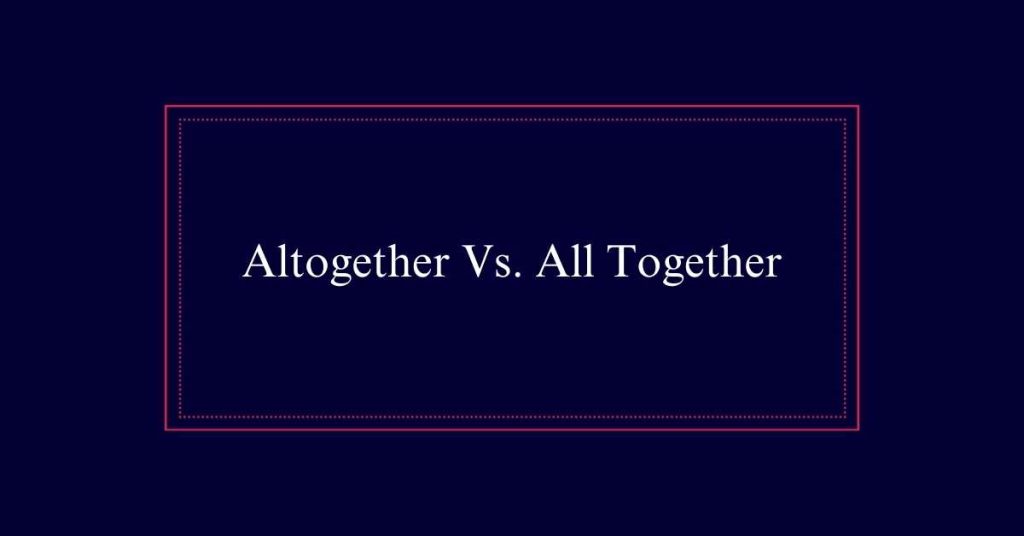Altogether Vs. All Together
“Altogether” is an adverb meaning completely or wholly. It summarizes situations, indicating totality. For instance, you might say, “The plan is altogether unworkable.” On the other hand, “all together” refers to everyone or everything in one place or doing something simultaneously. An example is, “We were all together at the meeting.” It emphasizes unity and collective action.
Definition of All Together
All together refers to all the members of a group being in the same place or doing the same activity. It implies unity and collective action.
For instance, ‘We went all together to the party’ shows the entire group attending the event as one. This phrase is often used to emphasize coordination and shared experiences.
It is not unusual to see a noun or verb inserted between ‘all’ and ‘together,’ such as in ‘After the reception, everyone should come all together to the garden.’ These constructions highlight the importance of group cohesion.
Definition of Altogether
To conclude, ‘altogether’ emphasizes unity and collective action, while ‘altogether’ serves a different purpose entirely.
‘Altogether’ is a single-word adverb that means completely or wholly. It is used to indicate that something is entirely the case without exceptions. For example, ‘The project was altogether successful’ means the project was completely successful.
Moreover, ‘altogether’ can summarize a situation or present an overall view. For instance, ‘Altogether, the event went smoothly’ provides a general assessment of the event’s success. This adverb can also be synonymous with phrases like ‘on the whole’ or ‘all in all.’
Usage of All Together
Understanding the usage of ‘all together’ involves recognizing its application in uniting members of a group or collection. It signifies that everyone or everything is in the same place or doing the same action simultaneously.
For instance, ‘We went all together to the party,’ illustrates the idea of a group moving as one. It often appears with a noun or verb separating the words, such as, ‘After the reception, everyone should gather all together in the garden.’ This phrase emphasizes collective action or presence.

Usage of Altogether
‘Altogether’ is an adverb that signifies something is complete or total in extent. It is used to convey the idea of entirety or completeness. This single-word adverb can replace phrases like ‘all in all’ or ‘on the whole.’
- Completeness: It denotes a state of being whole.
- Summarization: Useful for summarizing points or ideas.
- Negation: Employed to indicate something does not happen at all.
- Emphasis: Adds strength to statements.
- Comparison: Highlights differences or similarities totally.
Examples of All Together
When using the phrase ‘all together,’ it typically refers to everyone or everything being in the same place or gathered simultaneously.
For instance, ‘The family was all together for the holiday dinner,’ illustrates how all members are present in one location.
Another example is, ‘The team worked all together to complete the project,’ demonstrating a collective effort.
In social settings, you might hear, ‘We sang all together at the concert,’ indicating a shared activity.
Even in logistical contexts, ‘The packages arrived all together,’ means items were delivered at the same time.
Examples of Altogether
In many cases, using ‘altogether’ can clarify the extent or completeness of an action. This single-word adverb is often employed to convey a sense of totality or finality.
For example:
- ‘Some businesses have closed their doors altogether.’
- ‘North American sales increased by 3.3% to $2.66 billion altogether.’
- After the new policy, the old system was abandoned altogether.
- ‘The project was deemed altogether too risky to pursue.’
- ‘The lecture was altogether impossible to understand.’
Common Mistakes
Many people often confuse ‘altogether’ with ‘all together,’ leading to common grammatical errors in writing.
‘Altogether’ is an adverb meaning completely or entirely. For example, ‘The plan was altogether flawed.’
On the other hand, ‘all together’ refers to all members of a group acting in unison, such as, ‘We arrived all together at the meeting.’
A frequent mistake occurs when writers use ‘altogether’ to describe a group action, or ‘all together’ to mean completely. Misusing these terms can change the intended meaning of a sentence.
For example, saying ‘The team worked altogether’ is incorrect; it should be ‘The team worked all together.’lanations and recommendations, making it an indispensable tool for writers.
Tips for Correct Usage
Start by recognizing the context in which you are writing to determine whether to use ‘altogether’ or ‘all together.’ ‘Altogether’ is an adverb that means completely or entirely. Use it when you want to convey totality, such as in ‘The plan failed altogether.’
In contrast, ‘all together’ refers to a group acting collectively or being in one place. It involves multiple entities, like in ‘They arrived all together at the meeting.’
Remember, if you can replace ‘altogether’ with ‘completely’ and it still makes sense, then ‘altogether’ is correct. If you mean everyone or everything in one place, use ‘all together.’
Understanding these distinctions guarantees precise and clear communication.
Related Grammar Topics
Understanding related grammar topics enhances overall writing skills and guarantees effective communication. Mastering the distinction between ‘altogether’ and ‘all together’ is just one aspect.
Other related topics can further refine your language proficiency. Consider exploring the following:
- Homophones: Words that sound the same but have different meanings (e.g., ‘there’ vs. ‘their’).
- Subject-Verb Agreement: Ensuring subjects and verbs match in number (singular vs. plural).
- Punctuation: Proper use of commas, periods, and other marks.
- Sentence Structure: Crafting clear, concise sentences.
- Common Confusions: Differentiating words like ‘affect’ vs. ‘effect’.






